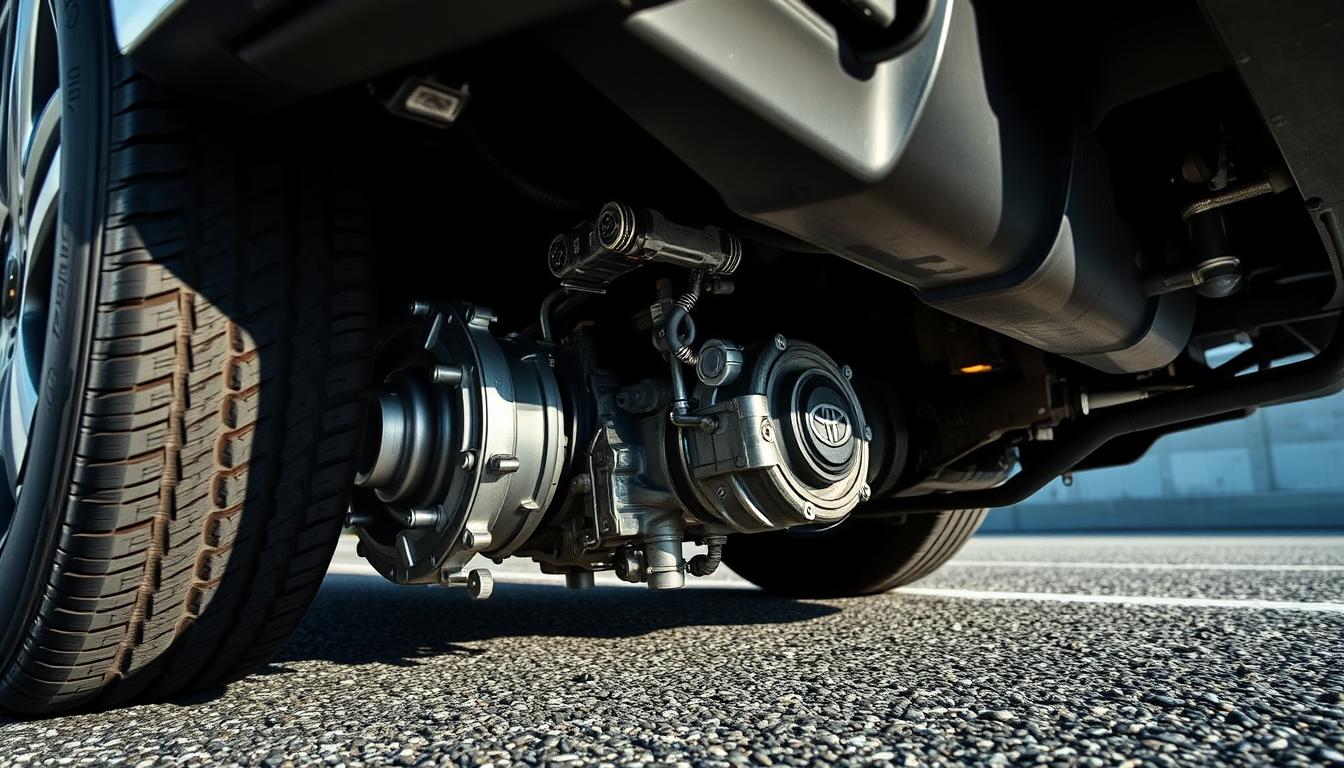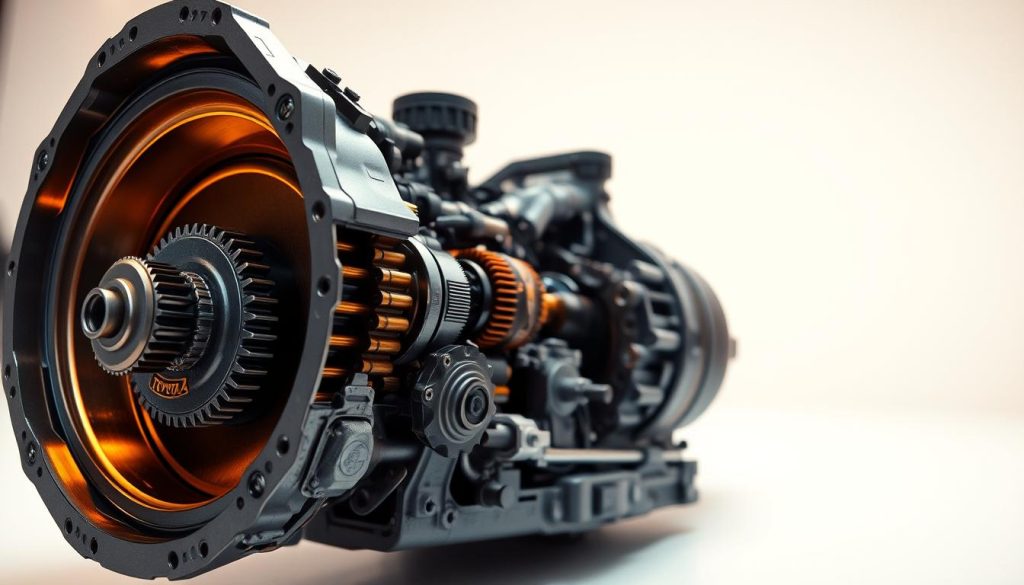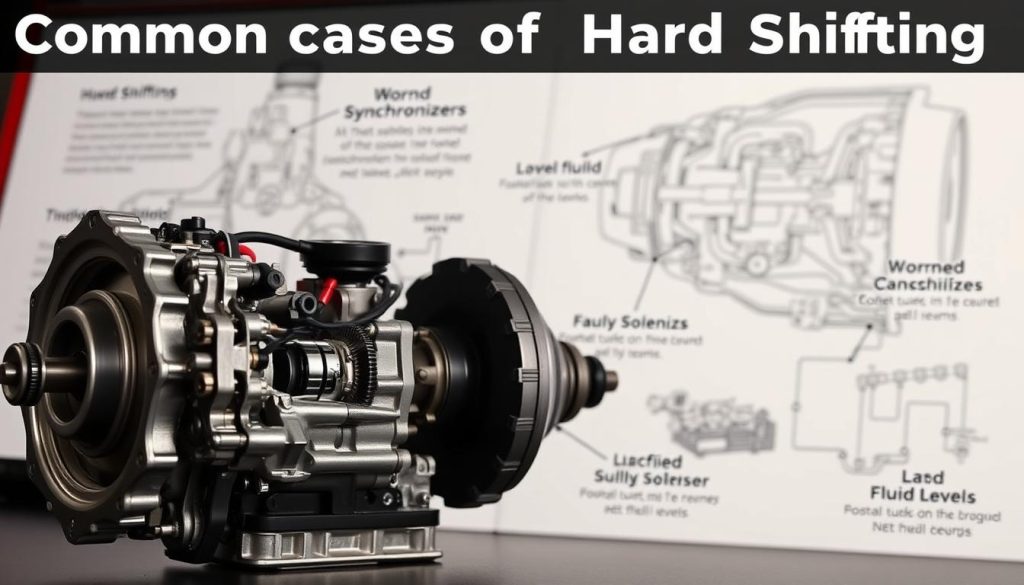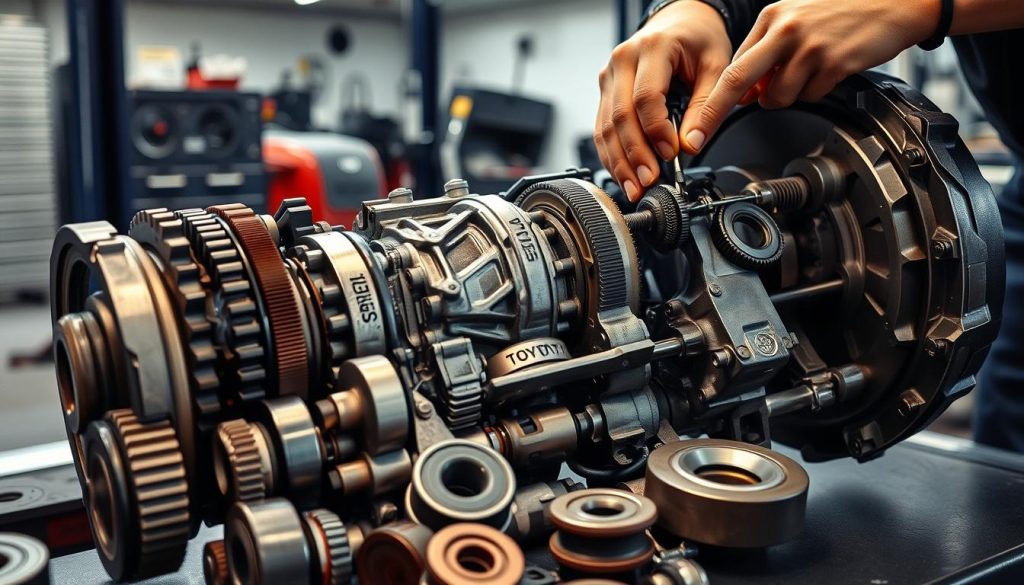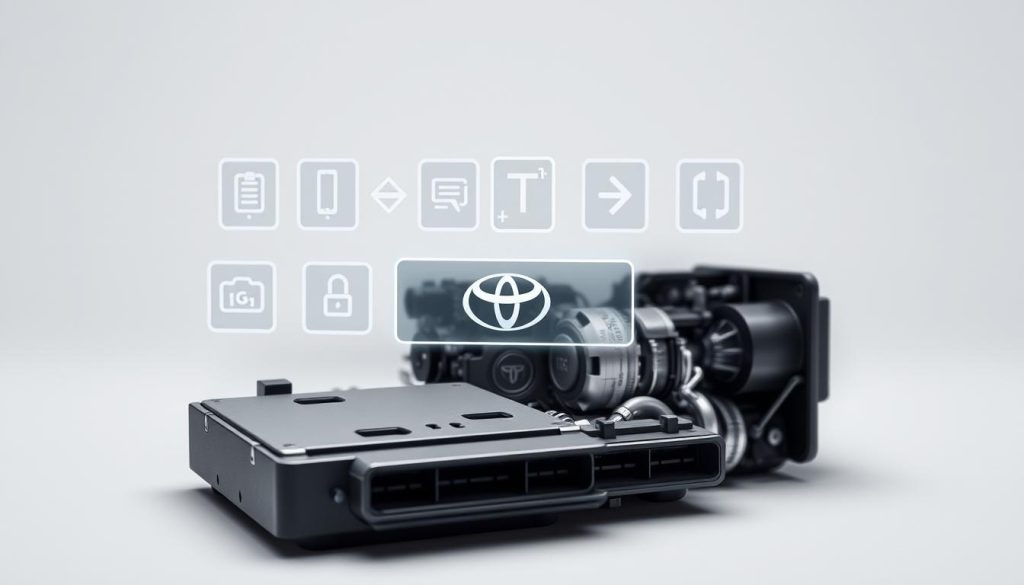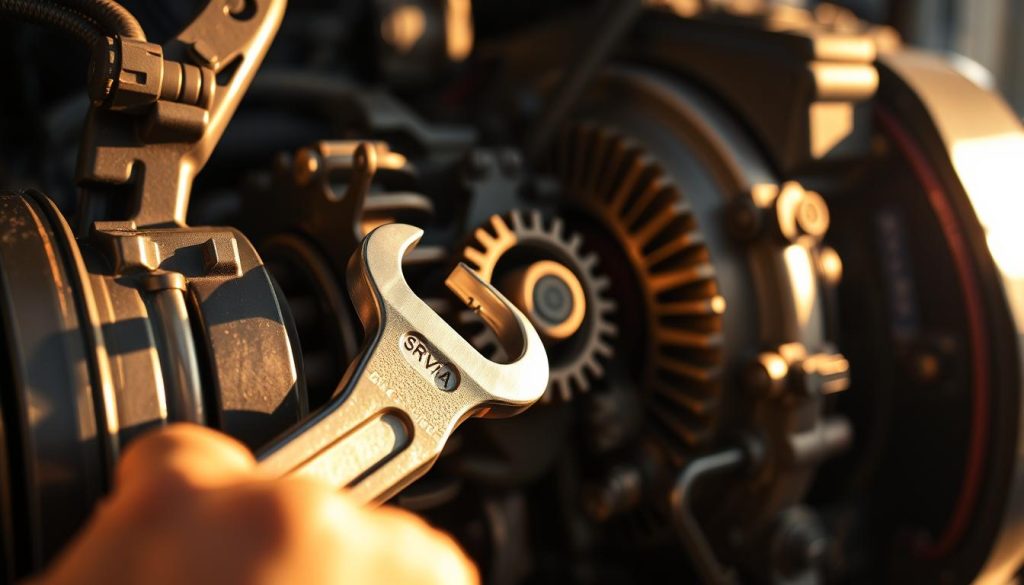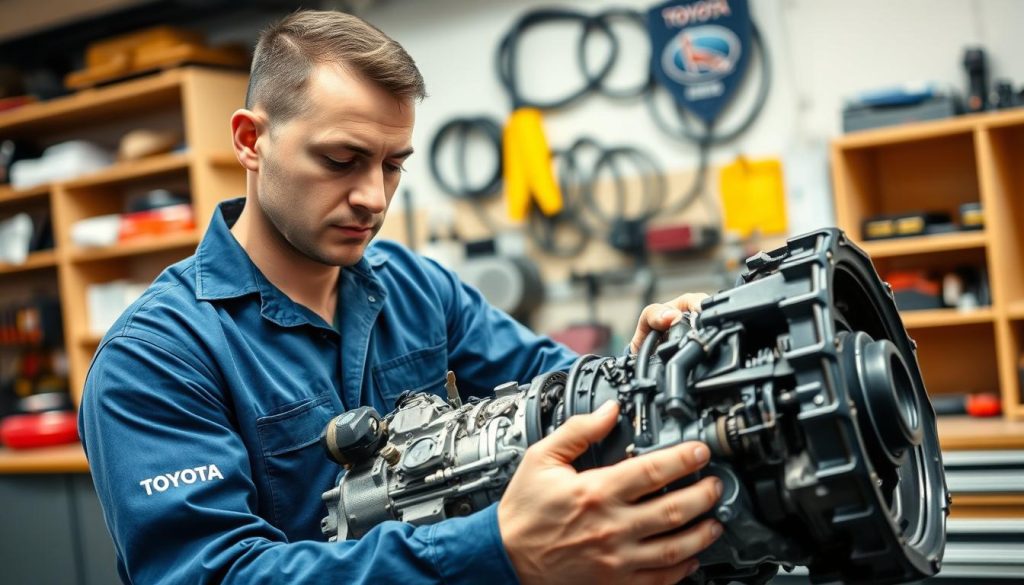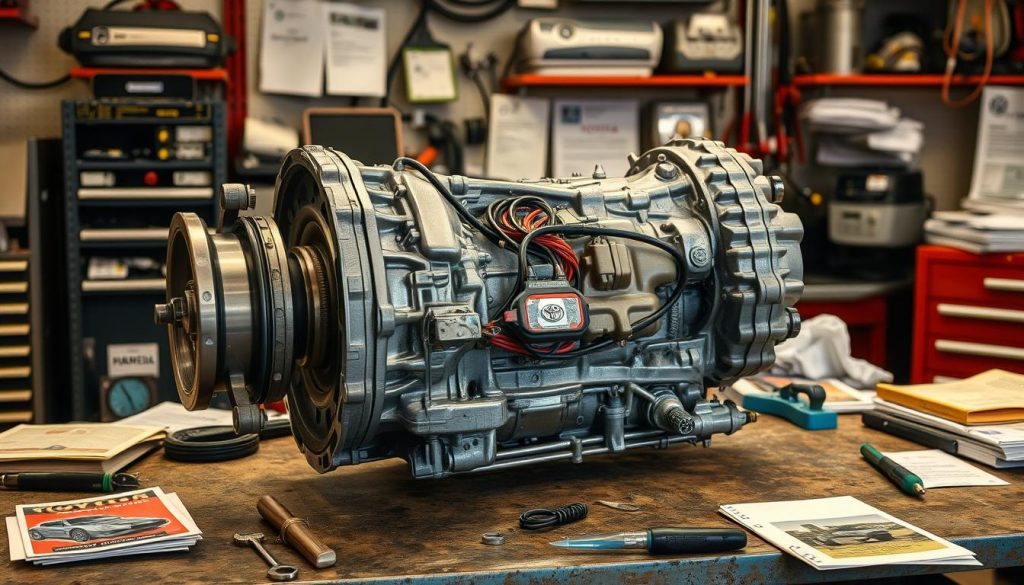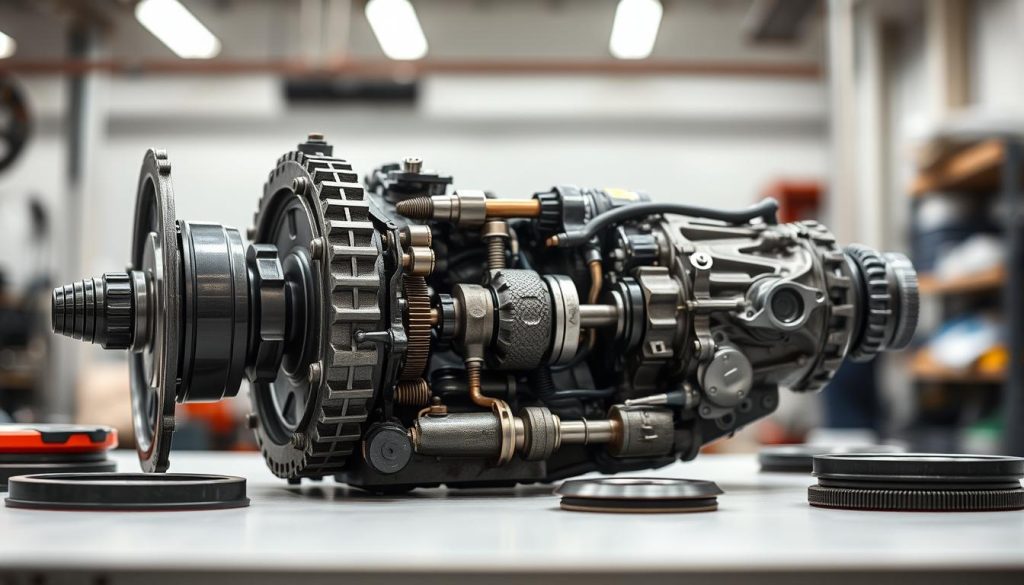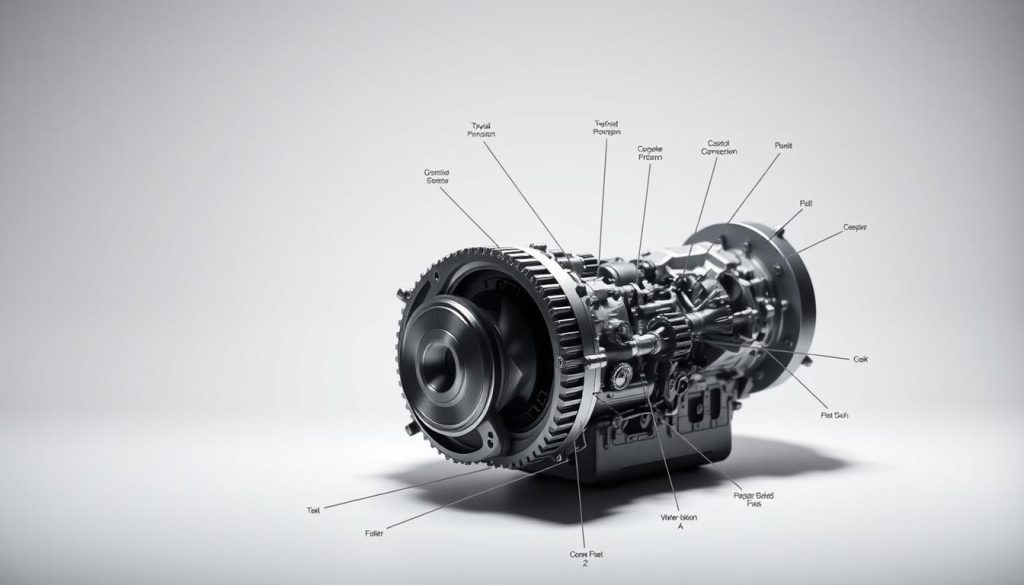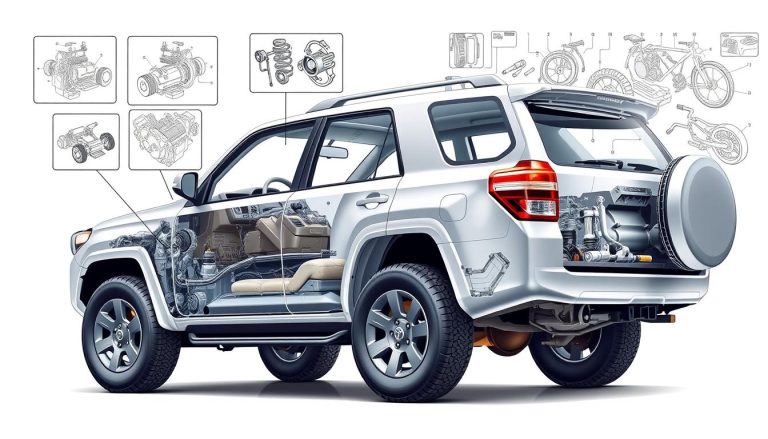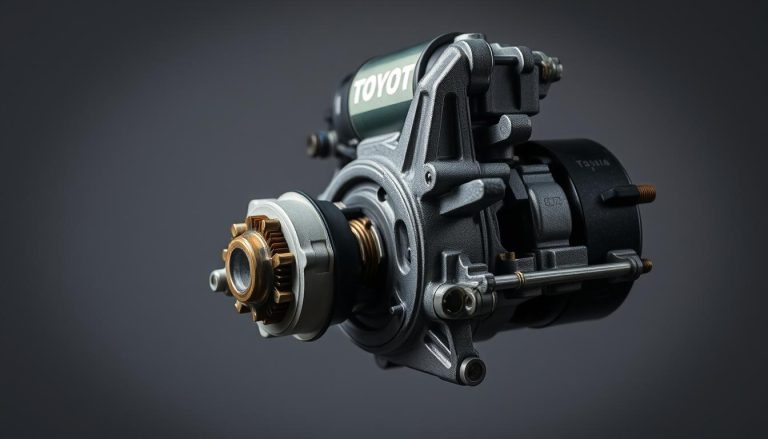Resolve Toyota Hard Shifting Issues: A Complete Guide
Are you dealing with Toyota hard shifting and looking for a solution? You’re in the right spot. This guide will help you find ways to fix Toyota gearbox problems. You’ll learn about Toyota transmissions, spot common symptoms, and get tips for DIY fixes and professional help.
By the time you finish this guide, you’ll know how to make your Toyota shift smoothly again. You’ll also learn how to make your Toyota last longer.
Understanding the Transmission System in Toyota Vehicles
The Toyota transmission system is key to a great driving experience. It connects the engine to the wheels, making sure power is transferred smoothly. Taking care of your transmission can make your car last longer and run better.
The Role of the Transmission
The car transmission manages the engine’s power and sends it to the wheels. This lets you change speed and direction easily. In Toyotas, this system works with high precision for a balanced drive.
It turns engine power into motion, making your car respond well to your commands. This keeps your speed steady and saves fuel.
Importance of Proper Transmission Function
Having a well-working Toyota transmission is vital for your car’s health and performance. Regular checks and care can avoid expensive fixes and improve your drive. Knowing how to take care of your transmission helps spot problems early.
Recognizing the Symptoms of Toyota Transmission Problems
Spotting early symptoms of Toyota transmission problems can save you from expensive fixes and make driving smoother. If you drive a Toyota, knowing these signs is key. They can show if your car’s transmission is facing issues.
Delayed Gear Engagement
A sign of Toyota gearbox issues is when gears take too long to engage. If shifting from park to drive or reverse feels slow, your transmission might be having trouble.
Slipping Gears
Toyota rough shifting shows up as slipping gears. If your car shifts gears unexpectedly or has trouble staying in gear, it’s a big warning sign of transmission problems.
Unusual Noises
Listen for odd sounds like whining, humming, or clunking. These sounds usually mean there’s damage or wear inside your transmission.
Leaking Fluid
See if there are reddish spots under your car from leaking transmission fluid. Low fluid can cause overheating and more damage.
Burning Smell
A burning smell means your transmission might be overheating or burning fluid. You need to check it right away.
Dashboard Warning Lights
Lastly, dashboard lights like the “Check Engine” light can mean symptoms of Toyota transmission problems. These lights are there to warn you of issues that need quick checking.
Common Causes of Toyota Hard Shifting
It’s key to know why Toyota vehicles might shift hard. Things like low or dirty transmission fluid, bad sensors, worn-out parts, and software bugs can cause trouble. These issues make shifting stiff and hard.
Low or Dirty Transmission Fluid
Low or dirty transmission fluid is a big reason for hard shifting. Keeping the fluid clean and at the right level is vital. If you ignore this, your car might shift poorly because of too much friction.
Faulty Sensors
Bad sensors can also lead to shifting problems. Sensors send important info to the car’s computer, helping it change gears right. But if they fail, the car might shift wrong, causing hard shifting.
Mechanical Wear
As time goes by, parts inside the transmission wear out. This can make shifting unpredictable. It’s a common problem that shows why keeping up with maintenance is so important.
Software Issues
Software problems in the transmission control system are another big issue. Today’s Toyotas use software to manage the transmission. Bugs or old software can mess up shifting, leading to noticeable problems. Keeping the software current is part of good maintenance.
Knowing these common causes helps fix Toyota shifting issues. Regular checks and quick fixes can stop small problems from getting big. This keeps your car running smoothly.
DIY Solutions for Minor Toyota Transmission Issues
Fixing minor Toyota transmission problems is easier than you think. Just a few simple steps can help avoid bigger issues later.
Checking Transmission Fluid Levels
Checking your transmission fluid levels is key to keeping your Toyota gearbox in good shape. Low fluid can cause hard shifting and other problems. To check, make sure your car is on a level surface and the engine is warm.
Then, pull out the dipstick, wipe it clean, and reinsert it. Pull it out again to see the fluid level.
Inspecting Fluid Condition
Look at the fluid’s condition when you check its level. Good transmission fluid is bright red. If it’s dark or smells burnt, it’s time to change it.
Using old fluid can really hurt your gearbox.
Resetting the Transmission Control Module
Resetting the transmission control module can fix shifting problems caused by software glitches. This reset can fix minor electronic issues and make shifting smoother. To reset, disconnect your car battery for 30 minutes, then reconnect and drive to let it recalibrate.
Ensuring Proper Driving Habits
Good driving habits are also important for your transmission. Avoid sudden acceleration and braking, as they can stress your transmission. Also, let your car warm up in cold weather before driving hard.
When to Seek Professional Help
If you’ve tried fixing your car’s transmission yourself but it’s not working, it’s time to get help from a pro. Certified Toyota technicians have the skills and tools to fix your car right at a Toyota service center.
Diagnostic Scans
A Toyota technician will use special tools to check your car’s systems. These scans help find the exact problem with your transmission. This way, your car gets the right fix it needs.
Mechanical Component Inspections
The Toyota service center can check your car’s parts closely. They look for worn-out parts, broken gears, or other issues that cause hard shifting.
Transmission Fluid Flushes
Transmission fluid can get dirty or lose its strength over time. A Toyota technician can change the old fluid for new one. This makes your car run better and last longer.
Reprogramming the Transmission Control Module
Shifting problems can also come from software issues in the Transmission Control Module (TCM). A Toyota service center can update the TCM. This makes sure your car’s transmission works well and smoothly.
Troubleshooting U140/U240 and U150/U250 Transmissions
When dealing with troubleshooting Toyota transmissions, like the U140, U240, U150, and Toyota U250, knowing the right steps is key. These steps help figure out if problems are with the car’s computer or its parts. This ensures we fix the issue correctly.
Memory Reset Procedure
Resetting the memory is a basic step for U140 transmission problems. You need to disconnect the battery for at least 30 minutes. This resets the Engine Control Unit (ECU). It clears error codes and might fix small software issues.
Solenoid Voltage Tests
Testing solenoid voltage is vital for the U250 transmission’s solenoids. Use a multimeter to check the voltage. It should match the specs. If it doesn’t, the solenoid might need to be replaced. This could fix shifting problems.
PCM Ground Checks
Checking the Powertrain Control Module (PCM) ground is key for electrical issues. It helps fix problems with the U140 and U240 transmissions. Make sure all ground connections are clean and secure. This simple check can improve the transmission’s performance.
| Procedure | Purpose | Tools Required |
|---|---|---|
| Memory Reset | Clear ECU error codes | None |
| Solenoid Voltage Tests | Evaluate solenoid health | Multimeter |
| PCM Ground Checks | Ensure proper grounding | Multimeter |
Preventative Maintenance for Toyota Transmissions
For the best Toyota transmission maintenance, it’s key to do regular preventative care for Toyota gearbox systems. Keeping your vehicle in top shape helps avoid sudden breakdowns. It also makes your car last longer.
Regular Fluid Changes
Keeping your transmission fluid clean is very important. Changing the fluid regularly stops dirt and harmful stuff from building up. This keeps your gearbox working well and your car running smoothly.
Routine Inspections
Regular checks are vital for preventative care for Toyota gearbox systems. Experts can spot problems early, saving you from expensive fixes. They check everything visually, test how it’s working, and use special scans to make sure your transmission is in great shape.
Using Genuine Toyota Parts
Choosing genuine Toyota parts is a must for keeping your transmission reliable. These parts are made just for Toyota cars and are tested to meet their high standards. Using real Toyota parts means your car will run better and last longer, giving you peace of mind.
Toyota Transmission Rebuilts and Replacements
Choosing between a rebuild or replacement for your Toyota transmission depends on several factors. These include the damage’s extent and the cost. Both options have their benefits and costs, which need careful thought.
Rebuild vs. Replacement
A Toyota transmission rebuild means replacing old parts with new or refurbished ones. It’s a cost-effective choice. But, if the damage is severe, replacing Toyota transmissions might be better. This ensures all-new parts and reliability.
Costs Involved
The cost of Toyota repairs differs between a rebuild and replacement. A rebuild might be cheaper upfront but could lead to more expenses later. On the other hand, replacing the transmission costs more initially but offers long-term peace of mind and better performance.
Software-related Transmission Issues
Software problems in Toyota transmissions can cause noticeable issues. Luckily, these can often be fixed by updating or reprogramming the Transmission Control Module (TCM). This makes sure the transmission has the latest software, fixing bugs and improving how it works.
Updating Transmission Control Module
Updating the TCM means installing the newest Toyota gearbox software. These updates make the transmission work better, more efficiently, and fix problems from older versions. The update needs special tools and software for a complete and accurate upgrade.
Reprogramming Process
The reprogramming of the Toyota TCM is more complex than a simple update. It involves resetting the module and then loading the new software to adjust the transmission’s performance. This can greatly improve how the transmission shifts, making driving smoother. It’s best done by certified technicians who know Toyota’s specific needs and methods.
Case Study: Overcoming Hard Shifting in Toyota Rav4
This Toyota case study looks at a common problem: hard shifting in the Toyota Rav4. It shows how to diagnose and fix this issue. It highlights the detailed steps needed to solve transmission problems.
Identifying the Issue
First, we need to understand the symptoms of hard shifting in a Toyota Rav4. Signs include slow gear changes, sudden shifts, and jerks when accelerating. Technicians start by checking the transmission fluid and looking for any dirt or contamination.
Steps Taken for Resolution
To fix hard shifting in the Toyota Rav4, several steps were taken:
- Initial Diagnostics: Detailed scans were done to find any issues with the transmission.
- Fluid Check and Replacement: The transmission fluid was checked and replaced if needed.
- Solenoid Tests: The solenoids were tested to make sure they were working right.
- Software Update: The Transmission Control Module (TCM) was updated with the latest software.
- System Reprogramming: The TCM was reprogrammed for the Toyota Rav4’s specific needs.
This careful process fixed the hard shifting problem. It shows how important it is to use detailed diagnostics, mechanical checks, and software updates. This Toyota case study proves that these steps are key to solving hard shifting in Rav4 models.
Toyota Transmission Expert Insights
Keeping your Toyota’s transmission in top shape is key to its long life and performance. Certified Toyota technicians use the latest tools and genuine parts. This makes a huge difference.
Benefits of Certified Technicians
Certified Toyota technicians have the skills and knowledge to care for your car’s transmission. They are trained to diagnose and fix problems accurately. This keeps your car running smoothly and reliably.
Advanced Diagnostic Tools
These experts use top-notch diagnostic tools to find and fix transmission issues. These tools help them inspect and identify problems precisely. This leads to quick and effective repairs, getting your car back to its best.
The Importance of Genuine Parts
Using genuine Toyota parts for repairs and maintenance is vital. These parts meet Toyota’s high standards, ensuring they fit and last well. This keeps your car’s value up and gives you peace of mind.
Understanding the Costs and Investments in Transmission Repairs
Regular maintenance and timely repairs are key to a Toyota’s transmission system lasting long and working well. Knowing the cost of Toyota transmission repair and the value of investing in Toyota maintenance can save you money in the long run.
Estimating Repair Costs
Several factors affect the cost of Toyota transmission repair, like the damage’s extent and the vehicle model. Costs can vary from a few hundred dollars for small fixes to thousands for major overhauls. Here’s a quick look at what you might pay:
| Service Type | Estimated Cost Range |
|---|---|
| Minor Repairs (e.g., seal replacements) | $150 – $500 |
| Moderate Repairs (e.g., solenoid replacements) | $500 – $1,500 |
| Major Repairs (e.g., transmission rebuild) | $1,500 – $3,500 |
| Transmission Replacement | $3,000 – $7,000 |
Long-term Savings with Proper Maintenance
The initial cost of Toyota transmission repair might seem high, but the long-term savings are worth it. Investing in Toyota maintenance through regular fluid changes and inspections can prevent costly repairs. By staying on top of maintenance, you can extend your transmission’s life and improve your car’s performance.
Understanding both the short-term repair costs and the long-term maintenance benefits can lead to big savings on Toyota repairs. Keeping your transmission in good shape not only makes driving smoother but also increases your car’s value.
The Importance of Addressing Transmission Issues Early
Fixing Toyota transmission problems early is key to keeping your car running well. Starting with early Toyota transmission repair stops small issues from becoming big, expensive problems. Regular preventive Toyota maintenance helps find and fix problems before they affect your car’s performance.
A timely transmission check can prevent Toyota owners from facing sudden breakdowns. Regular checks, like looking at the transmission fluid, can spot early signs. This way, you can fix issues before they cost a lot and keep your car running smoothly.
In short, sticking to preventive Toyota maintenance and regular timely transmission checks makes driving safer and more reliable. It also keeps your car in top shape for a long time, giving you peace of mind.
Toyota Hard Shifting: Real-World Solutions and Practical Tips
Real-world Toyota fixes often come from other Toyota owners. Learning from their experiences can give you confidence and useful knowledge.
Success Stories from Toyota Owners
Many Toyota owners have solved hard shifting problems. For example, a Toyota Camry owner improved shifts by changing the transmission fluid and resetting the module. These real-world Toyota fixes show the value of keeping fluids clean and at the right level.
Another Toyota Highlander owner fixed shifts by fixing software issues. This shows the importance of checking both mechanical and software solutions.
Practical Tips for Smooth Shifts
Knowing practical Toyota transmission tips can make your car run better. Here are some steps to follow:
- Regularly check and change transmission fluid: Make sure the fluid is at the right level and clean.
- Reset the Transmission Control Module: A simple reset can often fix minor issues.
- Address software updates: Keeping your vehicle’s software up-to-date can prevent shifting problems.
- Use genuine Toyota parts: Using only certified parts can prevent issues and extend your transmission’s life.
By following these practical Toyota transmission tips, you can drive smoother and keep your car running longer. Remember, timely Toyota owner advice and preventive care can save you from expensive repairs.
Conclusion
This guide helps Toyota owners understand how to keep their transmissions in top shape. Knowing how to spot problems early and when to get help can save a lot of hassle. Regular maintenance and using Toyota parts can make your car last longer.
Being proactive is key to a smooth-running transmission. Checking fluids, looking for wear, and updating software are all important steps. These actions help keep your transmission working well.
Early action and following recommended maintenance are essential. This guide shows that keeping your transmission healthy is possible with the right knowledge. Stay informed and proactive to keep your Toyota running smoothly.
FAQ
What are the common symptoms of Toyota transmission problems?
Signs include delayed gear engagement and slipping gears. You might also hear unusual noises or see fluid leaks. A burning smell and dashboard lights can also indicate issues.
What causes Toyota hard shifting?
Hard shifting can stem from low or dirty transmission fluid. Faulty sensors, mechanical wear, or software problems also play a role.
Can I fix minor Toyota transmission issues myself?
Yes, you can tackle some minor problems yourself. Check the transmission fluid levels and condition. Reset the Transmission Control Module if needed. Also, drive smoothly to avoid issues.
When should I seek professional help for my Toyota transmission issues?
For serious problems, get professional help. They can do diagnostic scans and inspect mechanical parts. They can also flush the transmission fluid and reprogram the Transmission Control Module.
What are U140/U240 and U150/U250 transmissions?
These are specific Toyota transmissions. Troubleshooting them might involve resetting the memory. You might also need to test solenoid voltage and check the PCM ground.
How often should I perform maintenance on my Toyota transmission?
Regular maintenance is key. Change the fluid, do routine inspections, and use genuine Toyota parts. This keeps your transmission in top shape.
Should I rebuild or replace my Toyota transmission?
The choice between rebuilding or replacing depends on the damage and costs. A professional diagnosis can help decide the best option.
Can a software issue cause Toyota transmission problems?
Yes, outdated or corrupted software can cause issues. Updating or reprogramming the Transmission Control Module can often fix these problems.
How was the hard shifting issue in the Toyota Rav4 resolved in the case study?
The problem was found with diagnostic tools. A fluid change and software updates were then done to fix it.
What are the benefits of using certified Toyota technicians?
Certified technicians have the right tools and knowledge. They also have access to genuine parts. This ensures reliable and effective repairs.
How can I estimate the costs for Toyota transmission repairs?
To estimate costs, consider labor, parts, and the issue’s severity. Regular maintenance can save you money by avoiding costly repairs later.
Why is it important to address transmission issues early?
Fixing problems early can prevent them from getting worse. This saves time, money, and keeps your vehicle running longer.
What practical tips can help prevent hard shifting in my Toyota?
Regular maintenance and smooth driving are key. Timely inspections also help prevent hard shifting, as shared by Toyota owners.

